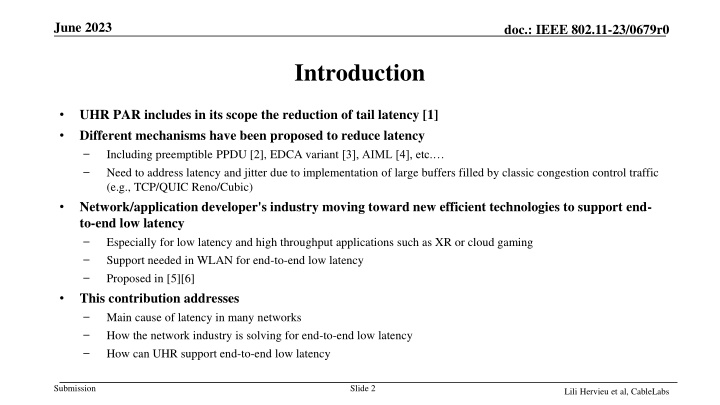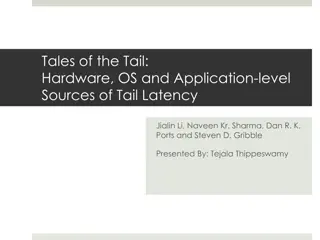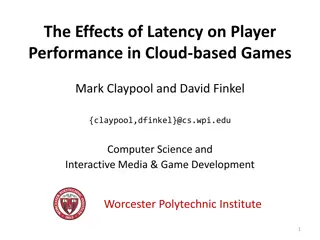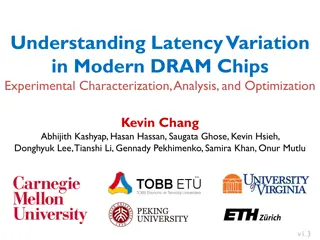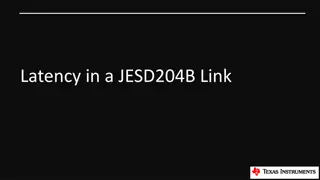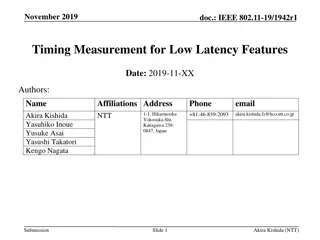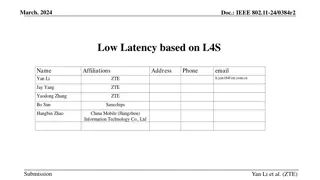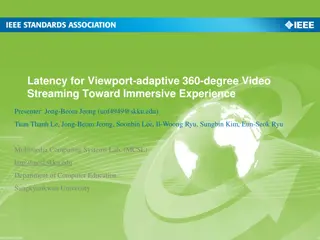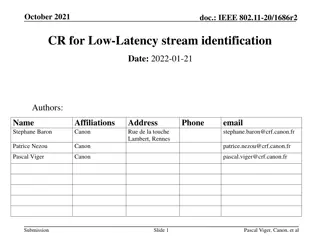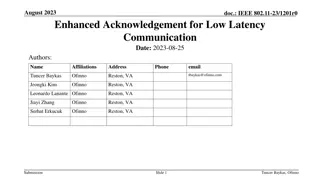Addressing Latency in Wi-Fi Networks: Industry Solutions and Support Needs
This document explores the sources of latency in WLANs and the industry's efforts to reduce latency and jitter for end-to-end low latency support. It highlights issues such as queueing delays, large buffers, and congestion control traffic, proposing mechanisms like preemptible PPDU and EDCA variants. The need for efficient technologies, especially for high-throughput applications like XR and cloud gaming, is emphasized. Additionally, it discusses the queuing delays observed in APs and non-AP STAs in WLANs, addressing the challenges posed by TCP/QUIC traffic and large buffer occupancy. The document also introduces the Low-Latency, Low-Loss Scalable Throughput (L4S) Architecture developed by the IETF to tackle end-to-end latency issues and the necessity for support in both network and application domains.
Uploaded on Mar 09, 2025 | 1 Views
Download Presentation

Please find below an Image/Link to download the presentation.
The content on the website is provided AS IS for your information and personal use only. It may not be sold, licensed, or shared on other websites without obtaining consent from the author.If you encounter any issues during the download, it is possible that the publisher has removed the file from their server.
You are allowed to download the files provided on this website for personal or commercial use, subject to the condition that they are used lawfully. All files are the property of their respective owners.
The content on the website is provided AS IS for your information and personal use only. It may not be sold, licensed, or shared on other websites without obtaining consent from the author.
E N D
Presentation Transcript
June 2023 doc.: IEEE 802.11-23/0679r0 Introduction UHR PAR includes in its scope the reduction of tail latency [1] Different mechanisms have been proposed to reduce latency Including preemptible PPDU [2], EDCA variant [3], AIML [4], etc. Need to address latency and jitter due to implementation of large buffers filled by classic congestion control traffic (e.g., TCP/QUIC Reno/Cubic) Network/application developer's industry moving toward new efficient technologies to support end- to-end low latency Especially for low latency and high throughput applications such as XR or cloud gaming Support needed in WLAN for end-to-end low latency Proposed in [5][6] This contribution addresses Main cause of latency in many networks How the network industry is solving for end-to-end low latency How can UHR support end-to-end low latency Submission Slide 2 Lili Hervieu et al, CableLabs
June 2023 doc.: IEEE 802.11-23/0679r0 Source of Latency in Wi-Fi Networks Different causes of latency in WLANs have been and are being addressed Channel access Steering, roaming, etc. Dense environments A much-overlooked cause of latency is the queueing delay Queueing delay is present at bottleneck links in the network Due to the way that applications currently interact with the network (e.g., TCP/QUIC w/ Reno/Cubic) Exacerbated by the use of large buffers to enable high throughput The largest, solvable, source of latency and latency variation on the Internet For WLAN, queueing delay is observed on APs (downlink), non-AP STAs (uplink) and Multi-APs (downlink/uplink) This submission is addressing the queueing delay from the time MSDU enters the MAC to the time contention starts Queuing Delay does not include Media Access Delay (contention resolution, retransmissions, etc.) Submission Slide 3 Lili Hervieu et al, CableLabs
June 2023 doc.: IEEE 802.11-23/0679r0 Queuing Delay in Networks TCP Reno sending data for this capacity Buffer overflows, and packets drop Delay increases Buffer Packets dropped Real capacity Classical congestion control traffic TCP/QUIC (Reno, Cubic) leads to large buffer occupancy Packets waiting in queues for transmission add latency and latency variation Note: Reducing buffer size reduces throughput of Reno/Cubic based flows Submission Slide 4 Lili Hervieu et al, CableLabs
June 2023 doc.: IEEE 802.11-23/0679r0 Queuing Delay in Networks End-to-end problem arising from network and application interaction At each bottleneck, including WLAN links Requires an end-to-end solution involving both application and network aspects Low-Latency, Low-Loss Scalable Throughput (L4S) Architecture has been developed by IETF to solve this problem Developed and supported by networking industry and application providers Support is needed at bottleneck links including WLAN to send signals to applications Support is needed in applications - new sending behavior and response to network signals Submission Slide 5 Lili Hervieu et al, CableLabs
June 2023 How the Network Industry Solves Queuing Delays due to Congestion doc.: IEEE 802.11-23/0679r0 Low-Latency Low-Loss Scalable Throughput (L4S) Architecture RFC [7][8][9] New (L4S) congestion- controlled protocols Explicit Congestion Notification (ECN) Dual queue (AQM) implementation Specifications (RFCs) published January 2023 New congestion-controlled protocols solve the root cause of queuing delay due to applications creating large queues Make use of ECN field in the IP header to notify the client that congestion is experienced Dual Queue AQM (Active Queue Management) to support L4S and legacy traffic Submission Slide 6 Lili Hervieu et al, CableLabs
June 2023 doc.: IEEE 802.11-23/0679r0 L4S Technology - ECN & Scalable Congestion Control Protocols L4S Explicit Congestion Notification (ECN) is an end-to-end notification of network congestion without dropping packets Sender marks its packet as L4S capable Network sends early congestion signal by marking IP packet with a Congestion-experienced code (CE) Fine grained congestion notification Receiver send congestion feedback to the sender in layer 4 (fine grained congestion feedback) Sender implements L4S scalable congestion control algorithm Adjusts sending rate dynamically based on fine grained feedback Submission Slide 7 Lili Hervieu et al, CableLabs
June 2023 doc.: IEEE 802.11-23/0679r0 L4S Technology Dual Queue AQM Congested Network (e.g., AP downlink) Low Latency (LL) queue ECN/CE marking L4S sender (PRAGUE TCP) L4S receiver (PRAGUE TCP) ECN classifier Classic (legacy) sender (TCP Reno) Classic receiver (TCP Reno) Classic queue Packets dropped Dual queue AQM Dual queue implementation enables L4S flows and 'Classic' flows to coexist Classic queue for legacy TCP/QUIC flows like video streaming, downloads, bulk data Low Latency queue (shallow buffer) for L4S flows like AR/VR, HQ video conferencing, cloud gaming Solely for isolation, not prioritization (no winners & losers) Solution still works when 100% of applications adopt L4S! If an L4S flow increases latency in the Low Latency queue, it is moved to the classic queue (queue protection) No benefit for cheaters to mark traffic as L4S Submission Slide 8 Lili Hervieu et al, CableLabs
June 2023 doc.: IEEE 802.11-23/0679r0 Why Not Just Use Prioritization? Latency optimization has been historically addressed with prioritization Prioritization can give privileged access to the link, and can reduce media access delay in certain cases But doesn t work when the majority (or all) traffic would like low latency Traffic prioritization also doesn t solve the root cause of queueing delays at bottleneck links the lack of congestion feedback And, in many cases, it results in bandwidth disparity (lower priority classes can be starved by higher classes) In WLAN, scheduled channel access and EDCA can t effectively reduce queueing delay due to congestion Especially for low latency high throughput flows Submission Slide 9 Lili Hervieu et al, CableLabs
June 2023 doc.: IEEE 802.11-23/0679r0 Proposed L4S Support in UHR End-to-end low latency provided for L4S traffic in three ACs (BE, VI, VO) AC_BE & AC_VI support Dual-Queue AQM AC_BE for normal priority traffic AC_VI for high priority traffic No low latency queue needed for AC_BK Single classic queue is sufficient No classic queue needed for AC_VO Voice queue is already a shallow queue add support for L4S ECN Queue DSCP+ECN Field Description EDCA AC 001***** 010***** Background Classic queue (deep buffer) 1 AC_BK 000****0 011****0 Best Effort Classic queue (deep buffer) 2-A AC_BE 000****1 011****1 Best Effort L4S queue (shallow buffer) 2-B Video Classic queue (deep buffer) 3-A 10*****0 AC_VI Video L4S queue (shallow buffer) 3-B 10*****1 End-to-end low latency can be supported even in environments where all traffic uses AC_BE e.g., Operator residential AP deployments where DSCP is bleached due to network policy / network neutrality concerns Voice/L4S queue (shallow buffer) 4 11****** AC_VO DSCP mapping shown as example Submission Slide 10 Lili Hervieu et al, CableLabs
June 2023 doc.: IEEE 802.11-23/0679r0 L4S Benefits L4S technology enables L4S traffic to achieve low latency, low packet loss and high throughput Coexists with classic traffic ECN is not bleached in (most) networks In WLAN, EDCA can still be used to give priority Allows for safe and incremental deployment over Internet Supported in Linux & MacOS/iOS and application providers (e.g., cloud gaming / video conferencing) Implemented in DOCSIS and an active Work Item in 5G RAN Multiple interoperability events have been held over the past year Submission Slide 11 Lili Hervieu et al, CableLabs
June 2023 doc.: IEEE 802.11-23/0679r0 Summary Queueing delays are experienced at network bottlenecks Due to classic application behaviors and the implementation of large buffers to support them Implementation of smaller buffers reduces the throughput of these classic flows Traffic prioritization doesn t solve the problem L4S architecture supports end-to-end low latency while not reducing throughput New L4S protocols (e.g., TCP/QUIC/RTP PRAGUE) make use of the ECN field in the IP header to adapt to the network conditions No packet drop, finer granularity Dual queue AQM at network bottlenecks supports incremental deployments and coexistence with classic congestion-controlled protocols. Supported by network industry and application providers L4S should be supported in UHR to achieve end-to-end low latency Submission Slide 12 Lili Hervieu et al, CableLabs
June 2023 doc.: IEEE 802.11-23/0679r0 Straw Poll Do you support UHR studying L4S implementation to support end-to-end low latency ? Submission Slide 13 Lili Hervieu et al, CableLabs
June 2023 doc.: IEEE 802.11-23/0679r0 References [1] Proposed UHR PAR [2] Thoughts on Beyond 802.11be [3] Latency and Reliability enhancements for UHR [4] Requirements of Low Latency in UHR [5] A Perspective on UHR Features for Operator Residential Deployments [6] QoS Re-visited [7] Low Latency Low Loss Scalable Throughput (L4S) Deployments (RFC9330) [8] The Explicit Congestion Notification (ECN) Protocol for Low Latency, Low Loss, and Scalable Throughput (L4S) (RFC9331) [9] Dual-Queue Coupled Active Queue Management (AQM) for Low Latency, Low Loss, and Scalable Throughput (L4S) (RFC9332) Submission Slide 14 Lili Hervieu et al, CableLabs
June 2023 doc.: IEEE 802.11-23/0679r0 Appendix Submission Slide 15 Lili Hervieu et al, CableLabs
June 2023 doc.: IEEE 802.11-23/0679r0 Queuing Delay in Congested Networks Delays happen at any point of congestion in networks where ingress capacity > egress capacity Routers, Cable modems, APs Networks implement large buffers to support and optimize legacy TCP/QUIC (Reno/Cubic based) traffic At each node in the network where congestion is experienced Reno/Cubic congestion control algorithms try to utilize the full capacity of the network. Use packet loss as congestion signal Introduce significant latency, latency variation and packet loss as a result Submission Slide 16 Lili Hervieu et al, CableLabs
June 2023 doc.: IEEE 802.11-23/0679r0 Classic vs L4S Scalable Congestion Control Classic TCP flow L4S congestion protocol flows Classic congestion control L4S scalable congestion control L4S leads to consistently low queuing delay while enabling full link utilization Submission Slide 17 Lili Hervieu et al, CableLabs
